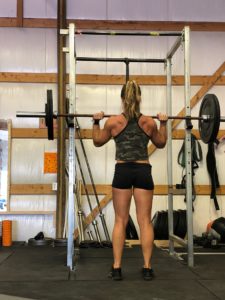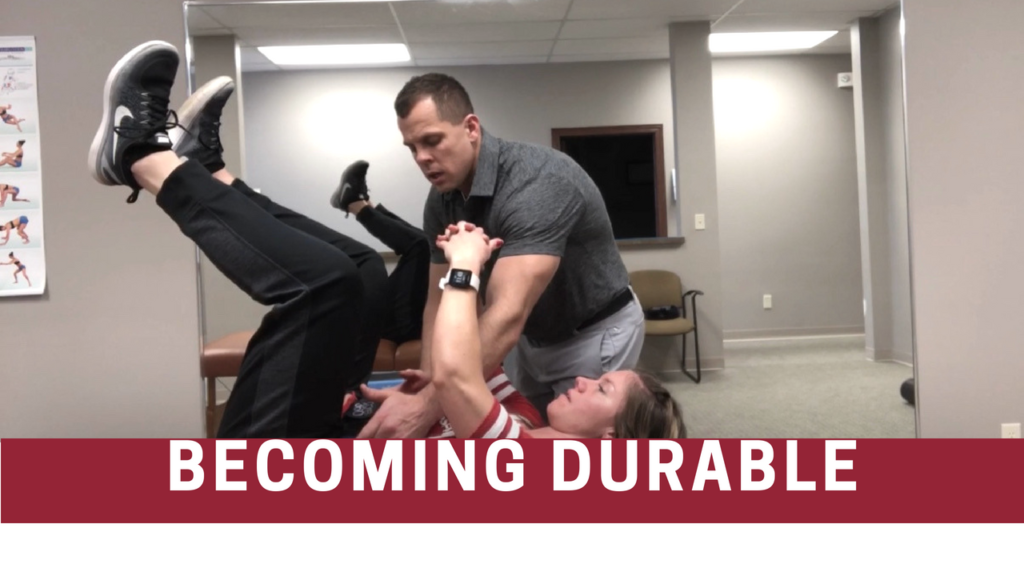This is part two of a series on my journey as I learned to deal with my injuries and become a healthier, stronger and more durable athlete. You can read Part 1 of the series here.
Summer 2017
I rented an office space at inMotion Spine Muscle and Joint in Maize, Kansas. Dr. Jared Shoemaker, one of the practicing chiropractors in the office, asked me about my shoulder pain after we briefly discussed it one day. We scheduled an assessment and he broke down various movement patterns of disconnect and weakness, based on a number of tests he had me complete.
I soon learned I had a LOT more going on than just a bad shoulder. I still had significant diatasis recti from my pregnancies with the girls. I had no ability to activate my transverse abdominis. My erector spinae were TOO strong and tight–despite always thinking my posterior chain was weak. I had significant thoracic spine tightness and immobility (which I knew, but attempts at improving it were not working), and I had no ability to pressurize through my low back/abs/obliques, and therefore was not breathing correctly. And guess, what?!? MY left side was the weakest…
The difference came in the plan of action. He told me constantly treating the pain with soft tissue work and other modalities like: foam rolling, trigger point release, stretching, and taping would only take care of the problem temporarily. That until I taught my brain how to communicate with my left side more efficiently, I was never going to truly get better. And would just continue to tear down good tissue with bad movement.
I had to start back over at the beginning. WAHHHHH!!
Becoming a Durable Athlete
The beginning as in, back to learning how I moved as a baby. My first 3 months of life. I created proper neural pathways between the brain and my body as an infant to help me move injury-free, but over time I (we) screw that up and create bad movement patterns that eventually become our “new norm.” And our bad movement patterns tear down tissue that we can only “work through” for so long before we have pain or injury.
So to the floor I went. To retrain my brain. FIRST.
See below, just some of the Dynamic Neuromuscular Stability (DNS) Training I was employing under Dr. Shoemaker’s guidance, which was purposeful in reawakening neural pathways of communication from my brain to my shoulder that were first created in infancy.
Part 1: Improving posterior capsule mobility.
https://www.instagram.com/p/Bc_JihBnk6_/?taken-by=shestrength
Part 2: Learning to use intrabdominal pressure with crawling.
https://www.instagram.com/p/Bc2VNn2nDT3/?taken-by=shestrength
Part 3: A New Exercise Plan to Retrain Core/Spine Stability
https://www.instagram.com/p/BcfIPNnjKQR/?taken-by=shestrength
Part 4: Learn to use intrabdominal pressure to power the barbell, not my thoracic spine
https://www.instagram.com/p/BcpwT3ejjKI/?taken-by=shestrength
I removed all overhead exercises from my protocol. No pull up’s. Rowing. Push up’s. Bench press. Snatch. Clean and Jerk. Ski erg. Swimming. NOTHING that would put my shoulder in a bad position or restart the bad neural communication between my brain and body.
It was NOT easy because I felt like I had to stop everything and start over. Dr. Shoemaker told me to give him a year. UGH!!
I would be lying if I didn’t tell you I was heartbroken. Scared. So depressed. And sometimes mad at it all. It just didn’t seem fair. I know, I know, life isn’t fair. But why?!
isn’t fair. But why?!
I kept to the program though…working my way through day by day. Just focusing on small improvements, changes, little things I seemed to get better at doing. Working on my mental game, figuring out once again who I am as a person outside of my strength training identity and passion. As well as remaining accountable to my treatment plan with frequent visits in Dr. Shoemaker’s office at inMotion Spine Muscle and Joint. Becoming a durable athlete.
Fast forward 6 months in…


Pingback: My Non-Surgical Shoulder Rehab Part III: The Nuts and Bolts - garagegymmagazine